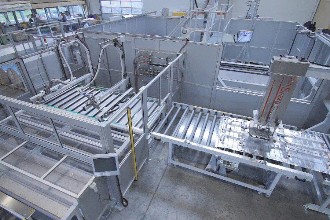

Tisun: One Machine to Make Complete Solar Absorbers
 The new absorber production unit at Austrian collector and tank manufacturer Tisun has turned out to be a success: Since October 2011, the Pulsspeed Bender forms the meander pipe, while welding it simultaneously to the absorber plate – and then soldering it to the manifolds. The machine delivered by Austrian machinery supplier DTEC GmbH even pulls in the working material by itself. The system, which produces an absorber every three minutes, consists of different stations for cutting the absorber plate, drilling holes in the manifold pipes, soldering the pipe register and testing the pressure levels of the completed absorber. The heart of the absorber production line is the station, which in one single step, bends the pipe and welds it to the plate.
The new absorber production unit at Austrian collector and tank manufacturer Tisun has turned out to be a success: Since October 2011, the Pulsspeed Bender forms the meander pipe, while welding it simultaneously to the absorber plate – and then soldering it to the manifolds. The machine delivered by Austrian machinery supplier DTEC GmbH even pulls in the working material by itself. The system, which produces an absorber every three minutes, consists of different stations for cutting the absorber plate, drilling holes in the manifold pipes, soldering the pipe register and testing the pressure levels of the completed absorber. The heart of the absorber production line is the station, which in one single step, bends the pipe and welds it to the plate.
Photo: DTEC/Tisun
“What is special about this machine is that you can freely program the shape and geometry of the meanders while the laser is under CNC control. This hasn’t been possible with conventional bending and laser-welding machines,” says Michael Dietl, Managing Director of the DTEC GmbH. Equipped with this type of machinery, one could do away with the huge bending tables that have been necessary for bending processes in conventional manufacturing. Manual handling and complicated logistics would also become a thing of the past.
The Pulsspeed Bender, how Dietl has named the absorber production unit, was an idea developed by him and the Technical Director of Tisun, Arnold Teufel. After the line pulls in an aluminium sheet from one side of the casing with a standard material roller, the sheet is sent through a cutting machine, which can cut both in length and sideways according to programmed dimensions. Then, the finished part is placed onto a work table. From the other side, it receives the two absorber manifolds for the absorber, which are attached to the plate. Afterwards, the machine’s tool head, which contains – among other things – the laser optics, moves into position and starts to weld the tubing to the absorber plate. The tubing can be either made of copper or aluminium. When this is done, the optics will be switched to the smaller diameter of the meander tube and can begin to weld this tube to the aluminium plate with a distance of 3 mm between each welding spot.
 The Pulsspeed Bender positions and welds the tube for a solar absorber meander at the same time. A roller presses the absorber tube onto the absorber plate, so that the laser can carry out the welding at exactly the right position.
The Pulsspeed Bender positions and welds the tube for a solar absorber meander at the same time. A roller presses the absorber tube onto the absorber plate, so that the laser can carry out the welding at exactly the right position.
Photo: DTEC/Tisun
Under the protective casing of the Pulsspeed Bender, the welded absorber moves on towards a soldering station, where the meander pipe will be joined to the two manifolds. “The soldering machine can automatically adjust to different combinations of material – be it copper-copper, copper-aluminium or aluminium-aluminium,” explains Dietl. By means of special controllers, flame intensity can be adjusted as well, in order to match different material combinations. Before the absorber can leave the machine, it will be docked to a measuring station, which checks for leaks by using a special method for the pressure differential. Finally, the work table moves the finished absorber to the removal point, at which is taken off by an employee.
Watch the video and see how the pulse laser works:
http://www.dtec.at/index.php/mediacenter.html
More information:
http://www.dtec.at/index.php/start-kopie.html
http://www.tisun.com/